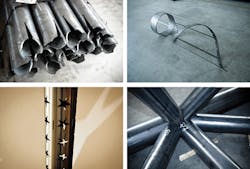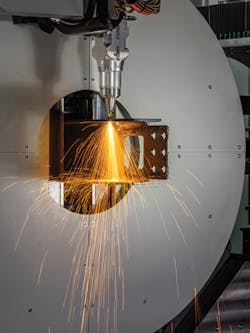Laser systems have use in large-diameter tube and pipe cutting
Fiber laser system reduces cost per cut part
GIOVANNI ZACCO
Laser cutting small- (< 6in.) and medium-diameter tubes (<12in.) is now a universally accepted industrial process. However, is laser tube cutting—specifically, when using a fiber laser—useful when it comes to large-diameter tubes? To find out the answer to this question, let us go to the Venetian hills in Italy, in the Prosecco wine region, to a company called Tubilaser (www.tubilaser.com). For more than 15 years, the company has been a supplier of structural steel tubing and laser-cut tubular components.
The company serves a wide variety of industries, including bridge and stadium construction (FIGURE 1), agricultural machinery, ski-lift structures for ski resorts, interior design and architectural elements, and general fabrication, among others. In short, its customers can be anyone that uses laser-cut tubular components (FIGURE 2). Tubilaser initially purchased BLM's laser tube cutting technology as a way to differentiate themselves from other fabricators. According to Guido Bonaldo, company owner, "it was a way for us to be able to offer our customers better quality components at a lower cost."
Moving into laser tube cutting
Tubilaser's first venture into laser tube cutting was with a BLM model LT652 small-diameter machine that uses a 2kW CO2 resonator to cut tubes up to 4.75in. diameter and 20ft. long. A second machine, an LTJumbo 20 3.5kW CO2 model, let the company process tubes up to 20in. diameter and 50ft. long with wall thicknesses of up to 0.625in. In addition to processing round tubes, the LT Jumbo 20 can also cut square, rectangular, oval, channel, angle, and I-beams (FIGURE 3).
In 2014, Tubilaser purchased its first fiber laser, a LT Jumbo 14 (14in. diameter) equipped with a 3kW IPG resonator. This addition enhanced their processing capabilities while adding more capacity for large-diameter jobs (FIGURE 4).
The decision to use the laser cutting process for large-diameter tubes was in part a logical decision because it allowed them to satisfy their customers' requirements, but it was also a result of entrepreneurial intuition that Bonaldo had about 15 years ago-far ahead of its time. He rightly realized the potential advantages offered by laser cutting, even in cutting large tubes. These advantages weren't as obvious at the time he made the investment. "Initially, all the customers treated my decision to invest such a large sum for a machine as sheer madness," he says, referring to his decision to buy the LT Jumbo 20. "In the early days, we did not receive any drawings requesting we quote on large components or structures. We had to work hard with our customers' engineering departments to convince the designers about the advantages of using the laser cutting process. These advantages were well-known for smaller tubes, but it took some time to convince the market that the same advantages were valid for larger, heavier tubes."
Slowly, Tubilasers' customers began to realize the benefits of laser cutting and started to implement innovative design solutions for their parts. Now, even for simple applications, the laser cutting process is automatically assigned. Flavio Colusso, Tubilasers' production manager, explains it this way: "The advantage does not lie in the automation of the manufacturing process for a single component, but they cover the entire production process for a given project and that results in the overall lower costs compared to the traditional processes." To explain Colusso's point, he gives this example: "Let us consider two 40ft.-long, large-diameter round tubes. These tubes are to be end-cut to form a 90° joint between them and they also have other pockets to be cut along their length, where additional tubes are to be inserted to form a tubular structure. Now, you will appreciate that these pockets have to be cut with correct orientation with respect to the end-cuts. A small error, even of 1° in terms of orientation, will cause considerable mismatch at the other end of the tube. Such errors are common when fabricating with traditional manual processes. The time required to rework the parts (often in the field) to correct these errors can be almost infinite. It means cost overruns and the quality of such rework from the aesthetic viewpoint is never good. The LT Jumbo family of laser tube machines can produce these types of large tubes in a single, completely automatic cycle with an accuracy and repeatability that cannot be matched by the old manual processes."
The 3D tilt cutting head of the machine can move along the full length of the tube as it is being is held by two rotary chucks. This approach offers high precision and flexibility in cutting the ends or pockets anywhere along the full length of the part. "All our customers are extremely satisfied with the precision and the quality of components that we supply," confirms Filippo Bonaldo, the founder's son. Thanks to the laser cutting process, Tubilaser is in a position to supply high-quality components with short lead times and low costs. This is a huge advantage when customers compare them to other shops who are trying to compete using the old traditional manual processes. The results, quality, and consistency cannot be compared.
"With traditional methods, the total time (and hence cost) required to produce a given component can't be determined in advance because it depends upon a number of factors, the most important of which is the operator skill," says Colusso. "The situation with [a] laser is different. The cost and time required to produce any given component, even with bevel cutting required as joint preparation for subsequent welding, can be calculated in advance. This calculated cost remains the same whether you produce one component or hundreds of them. This certainty about the cost and quality is highly appreciated by our customers."
"An example of one such successful project was the fabrication of complex tubular structures for railroads," says Bonaldo. "These structures are installed along a railway line and are used to hang signals and other indications for trains. These tubes were laser-cut and then sent to the site, ready to be assembled. No further adjustments or any kind of rework was required during their assembly and the structures were assembled like a puzzle." Touching upon another important aspect, he continues by explaining that "the operator skills in the traditional processes are not the same as they were once upon a time. In the past, an operator was capable of producing a component on his own once you gave him the drawing. New workers don't have the same skillset. Any mistakes made are very costly because either you have to spend a lot of time for rework and repair, or scrap everything and start anew. Since material cost for large-dimension tubes is very high, one can't afford to do this."
Fiber laser tube cutting benefits
Using a fiber laser on the LT Jumbo 14 was also not an obvious choice because the machine was designed to be used for large-diameter tubes with thick walls, and fiber lasers are known to offer their best performance in terms of higher cutting speed when used to cut thinner materials. The fiber laser was chosen for its overall lower operating costs. "The tubular construction and agricultural machinery sectors are extremely cost-sensitive—the component cost has to be minutely controlled," says Bonaldo. "Fiber laser technology, with its lower energy consumption (and, hence, lower installed power requirements) and lower maintenance, helps to reduce the cost per piece. It also adds the capability to cut other materials—galvanized, copper, brass, stainless—that can't be cut well with a CO2. This expanded capability is an important factor for any tube fabricating job shop. These advantages amply offset the small compromise that we have to accept with the quality of cut surface obtained." In fact, compared to an installation with a CO2 laser, the electrical power requirement is almost half; there is practically no maintenance required on the laser resonator because there are no moving parts in the fiber laser; and there is no chain of mirrors to guide the beam and, therefore, no question of their alignment, cleaning, and maintenance. With a CO2 laser, all these maintenance activities result into stoppage of machine and loss of production. In addition to that, the fiber laser has an additional standby power module inside the fiber laser that kicks into action in case one of the operating modules should have some problems.
The use of fiber laser technology compels the machine manufacturer to completely enclose the working area to ensure operator safety. On the LT Jumbo, the laser cutting process is viewed via video cameras installed in the working area. Bonaldo considers this aspect as a plus: "Since the working area is totally enclosed, the machine manufacturers have to pay extra attention to make certain the machine operation is more reliable and capable of resolving eventual hiccups in an automatic manner, as much as possible." An interesting point of view!
We can conclude that the challenge of using the laser cutting process for cutting large-diameter tubes has been overcome. There was some reluctance in the beginning, but now Tubilasers' customers have understood the advantages of having accurate, high-quality components that can be easily assembled and welded onsite, so the laser cutting process for such components has become their new standard. Designers working in this industry have also learned the potential new design freedoms offered by this technology, and they have started to use it freely to design innovative structures that are aesthetically pleasing.
Appealing designs, high part accuracy, lower piece part costs, reduced maintenance, and reduced assembly time all prove that Guido Bonaldo was right many years ago when he gambled to introduce laser tube cutting into large-diameter and heavy wall tube and pipe fabrication.
GIOVANNI ZACCO([email protected]) is the market development manager at BLM Group, Cantù, Como, Italy, www.blmgroup.it.



